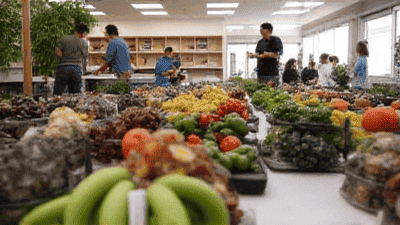
In a world increasingly driven by globalization, the rise of local food systems brings a refreshing perspective to our eating habits. Local ingredients not only offer a wealth of flavor and nutrition, but they also play a pivotal role in supporting community economies. As consumers become more conscious of where their food comes from, the importance of sourcing locally has never been clearer.
Local ingredients are those that are grown, harvested, and produced within a certain geographical area, typically within 100 to 150 miles of the consumer. This definition can vary depending on local guidelines, but the underlying principle remains the same: local foods are sourced from nearby farms and producers.
Freshness: Local ingredients are often harvested at their peak, meaning they retain more nutrients and flavor than those that have been transported long distances.
Seasonal Eating: When you choose local, you are often buying seasonal produce, which is typically fresher and more flavorful.
Connection to Food Sources: Engaging with local ingredients fosters a deeper understanding of food production and encourages respect for the land and its resources.

When you buy local ingredients, you are directly supporting local farmers and producers. This has a cascading effect on your community:
Job Creation: Supporting local agriculture helps create jobs, from farming and processing to transportation and retail.
Economic Stability: Money spent locally tends to circulate within the community, boosting local economies and creating a stronger economic foundation.
Reduced Dependency on Big Corporations: By focusing on local producers, communities can reduce their reliance on large agribusinesses, which often have significant environmental impacts and ethical concerns.
Local sourcing has several advantages for the environment:
Reduced Carbon Footprint: Transportation of food across long distances contributes significantly to carbon emissions. Local foods require less transportation, thereby reducing fossil fuel use.
Sustainable Farming Practices: Many local farmers prioritize sustainable agricultural practices, focusing on soil health, biodiversity, and responsible land management.
Preservation of Green Spaces: Supporting local agriculture helps preserve farmland and green spaces in your community, promoting biodiversity and protecting ecosystems.
Fresh, local produce is often more nutritious than foods that have traveled long distances:
Higher Nutrient Content: Local foods are often harvested at their peak ripeness, resulting in maximum flavor and nutritional value.
Fewer Preservatives: Foods grown locally typically have a shorter shelf life, which encourages producers to avoid harmful preservatives that some large-scale operations might use.
Engaging with local food systems fosters a sense of community:
Building Relationships: Getting to know local farmers and food producers creates social connections and enhances community bonds.
Cultural Identity: Local foods reflect the culture and history of a region, allowing communities to celebrate their culinary heritage.
Direct Feedback: When you purchase from local producers, you have an opportunity to provide feedback, building a collaborative relationship that can enhance food quality.
Farmers' markets are a fantastic way to connect directly with local producers. Here are tips for making the most of your visits:
Do Your Research: Find farmers' markets in your area and learn about the vendors ahead of time. Many markets have websites or social media pages.
Arrive Early: To get the best pick of the freshest produce, arrive early.
Engage with Farmers: Ask questions about farming practices and seek recommendations for how to prepare their products. Building relationships with local farmers enriches your shopping experience.
Community-Supported Agriculture connects consumers directly with local farms. Here’s how it works:
Subscription Model: You purchase a share of a farm's harvest in advance, and in return, you receive regular deliveries of fresh produce during the growing season.
Diversity and Surprise: CSAs often provide a wide variety of fruits and vegetables, encouraging you to try new recipes and embrace seasonal eating.
Not all grocery stores prioritize local sourcing, but many have sections dedicated to local products. To support local ingredients while grocery shopping:
Look for Local Labels: Many stores will have signage indicating locally sourced products. Familiarize yourself with local brands of dairy, bread, meat, and produce.
Ask Questions: Don’t hesitate to ask grocery store staff about local offerings. They may have recommendations for seasonal items or local vendors.
Growing your own food is not only a rewarding endeavor but also a great way to incorporate local ingredients into your diet. Here are some tips for starting your home garden:
Choose the Right Space: Use a backyard, balcony, or even windowsill for growing plants. Container gardening can be a fantastic option for limited spaces.
Select Easy-to-Grow Varieties: Start with herbs, tomatoes, lettuce, or radishes that are relatively easy for beginners.
Practice Sustainable Gardening: Use organic seeds and natural pest control methods to contribute to environmental wellness.
Many communities host food-related events that highlight local ingredients, such as festivals, farm tours, and cooking classes. Participate in these events to deepen your appreciation for local agriculture and cuisine:
Attend Food Festivals: Celebrate local flavors at festivals that feature farmers, chefs, and artisans sharing their offerings.
Take Cooking Classes: Look for classes focused on using seasonal ingredients, which validate the charm of local products while honing your culinary skills.

To illustrate the joy of cooking with local ingredients, here are a few simple yet delicious recipes that you can try. Each recipe encourages the use of fresh, seasonal produce that you may find from local farmers or at your farmers' market.
A classic French dish that showcases summer vegetables, perfect for a local ingredient celebration.
Take advantage of fresh, local fruit with this simple dessert.
Create a simple infused oil that can enhance the flavor of many dishes using local herbs.
The charm of local ingredients extends far beyond their delightful flavors; it is woven deeply into the fabric of community economies, environmental sustainability, and nutritional health. Supporting local farmers and food producers is not just a trend; it is a thoughtful and responsible choice that can lead to lasting change in our communities, ecosystems, and personal well-being.
By embracing the principles of locally sourced ingredients, we foster connections between ourselves and the producers, enrich our diets, and contribute to the economic vitality of our communities. Simple actions—such as shopping at farmers’ markets, joining a CSA, or growing your own herbs—can make a meaningful impact.